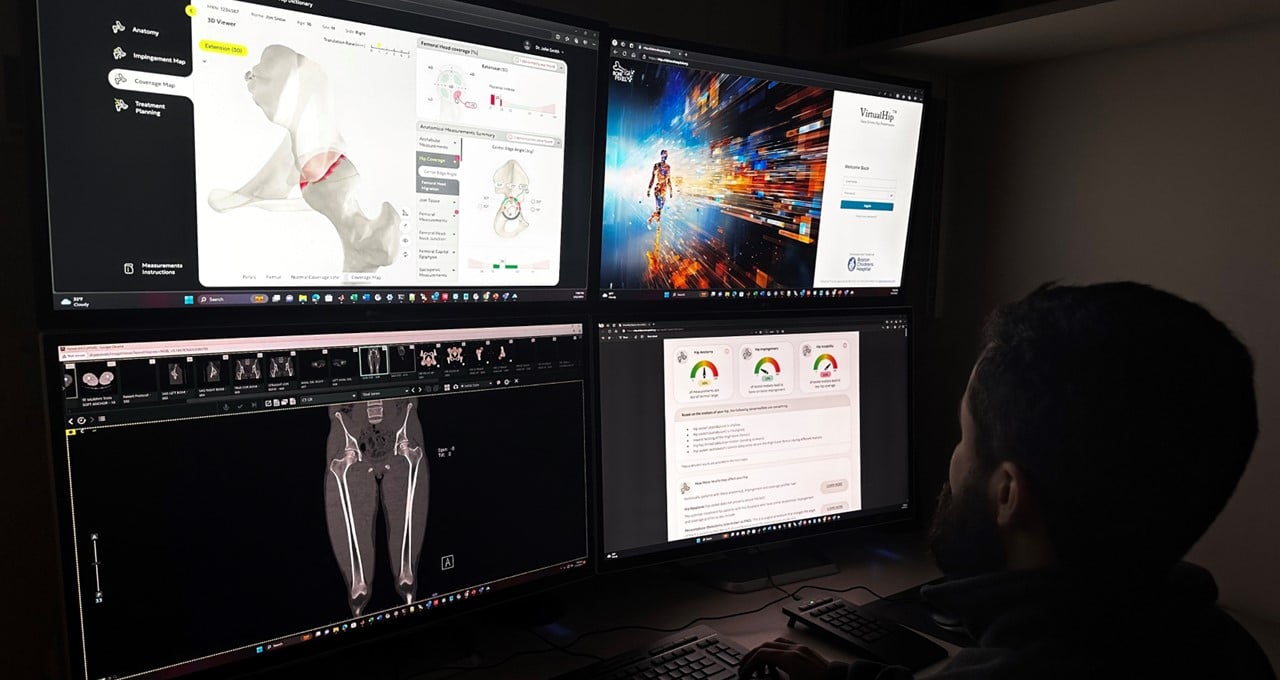
Hip problems, comprising among the world’s commonest joint illnesses, are particularly prevalent amongst adolescents and younger adults, inflicting stiffness, ache or a limp. However they are often arduous to diagnose utilizing solely 2D medical imaging.
Serving to to deal with these problems, the Boston Youngsters’s Hospital’s (BCH’s) Adolescent and Younger Grownup Hip Preservation Program is the U.S.’s first to deploy a completely automated AI instrument throughout its clinic.
Referred to as VirtualHip, the instrument can create a 3D mannequin of a hip from routine medical pictures, assess anatomy and movement-related points, and supply clinicians with diagnostic and therapy steerage. It was constructed at an orthopedic analysis lab at BCH, Harvard Medical College’s main pediatric hospital, utilizing the NVIDIA DGX platform.
A crew of 10 researchers are engaged on the venture, funded partially by an NVIDIA Educational {Hardware} Grant, together with engineers, laptop scientists, orthopedic surgeons, radiologists and software program builders.
“Utilizing AI, clinicians can get extra worth out of the scientific knowledge they routinely accumulate,” stated Dr. Ata Kiapour, the lab’s principal investigator, director of the musculoskeletal informatics group at BCH and assistant professor of orthopedic surgical procedure at Harvard Medical College. “This instrument can increase their efficiency to make higher decisions in analysis and therapy, and free their time to give attention to giving sufferers the perfect care.”
Getting Straight to the Joint
Usually, clinicians should decide a therapy plan — with ranges of intervention starting from bodily remedy to complete hip alternative — based mostly on only a 2D picture, comparable to an X-ray, CT scan or MRI. Routinely creating 3D fashions from these pictures, and utilizing them to conduct complete joint assessments, may help enhance the accuracy of analysis to tell therapy planning.
“I began a postdoc with an orthopedic surgeon at BCH in 2013, after I noticed how an engineer or scientist might assist with affected person therapy,” stated Dr. Kiapour, who’s additionally skilled as a biomedical engineer. “Through the years, I noticed that hospitals have a ton of knowledge, however environment friendly knowledge processing for scientific use was an enormous, unmet want.”
VirtualHip, totally built-in with BCH’s hip clinic and radiology database, helps to fill this hole.
Clinicians can log in to the software program instrument by way of a web-based portal, view and work together with 3D simulations of 2D medical pictures, submit evaluation requests and see outcomes inside an hour — 4x faster on common than receiving a radiology report after imaging.
The instrument, which produces 3D fashions with a margin of error lower than one millimeter, can assess morphological abnormalities and establish points associated to hip movement, comparable to ache from hip bones rubbing in opposition to one another.
VirtualHip was developed utilizing a database with tens of tens of millions of scientific notes and imaging knowledge from sufferers seen at BCH over the previous 20 years. Utilizing pure language processing fashions and laptop imaginative and prescient algorithms, Dr. Kiapour’s crew processed this knowledge, coaching the instrument to research regular versus pathologic hip growth and establish elements influencing the damage danger and therapy outcomes.
This can allow VirtualHip to supply patient-specific danger evaluation and therapy planning by evaluating present sufferers to beforehand handled ones with related demographic backgrounds.
“The {hardware} help that we bought from NVIDIA made all of this doable,” Dr. Kiapour stated. “DGX enabled superior computations on greater than 20 years’ value of historic knowledge for our fine-tuned scientific AI mannequin.”
Clearer Explanations, Higher Outcomes for Sufferers
Along with aiding docs in analysis and therapy planning, VirtualHip helps sufferers higher perceive their situation.
“When sufferers have a look at an X-ray, it doesn’t appear like an actual hip — however with a 3D mannequin that may be rotated, the physician can present precisely the place the joints are impinging or unstable,” Dr. Kiapour stated. “This lets the affected person higher perceive their dysfunction, which often makes them extra compliant with regardless of the physician’s prescribing.”
Such a visualization is particularly useful for kids and youthful adults, Kiapour added.
The VirtualHip venture is beneath steady growth, together with work towards a patient-facing platform — utilizing giant language fashions and generative AI — for customized analyses and therapy suggestions.
The BCH researchers plan to commercialize the product to be used in different hospitals.
Subscribe to NVIDIA healthcare information.